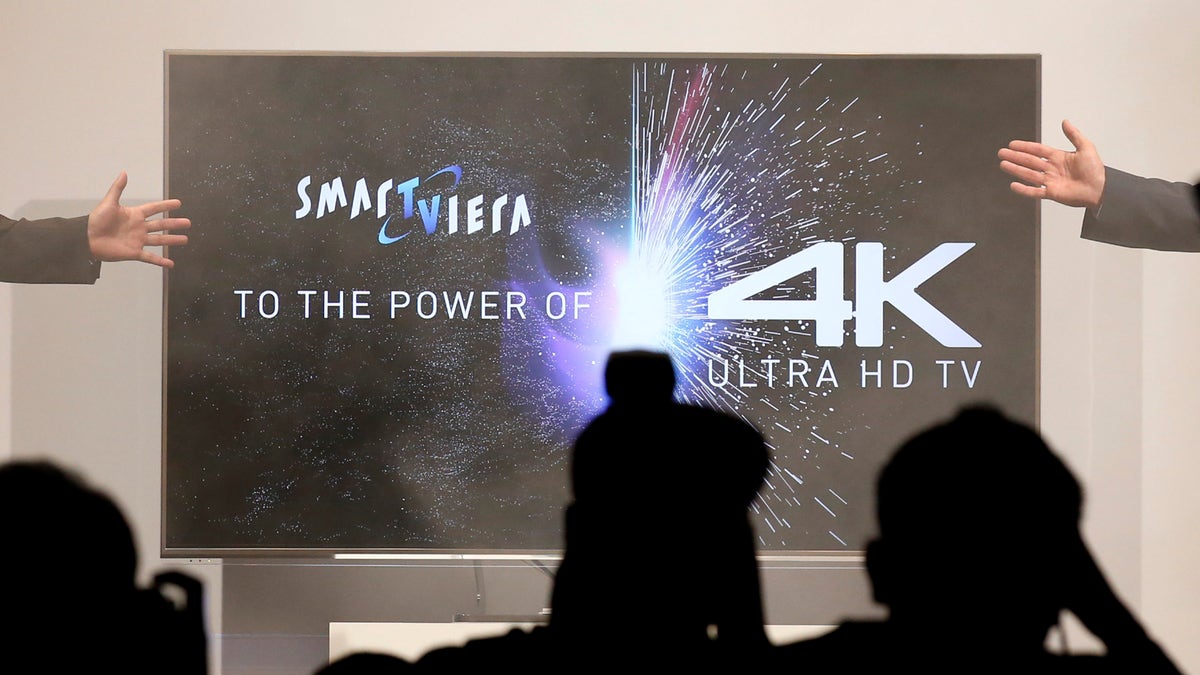
Journalists watch the introduction of the world's first L65WT600 Ultra HD TV with 4K 50/60Hz input at the Panasonic booth at the IFA consumer electronics fair in Berlin, September 4, 2013. The IFA consumer electronics and home appliances fair will open its doors to the public from September 6 till 11 in the German capital. REUTERS/Fabrizio Bensch (GERMANY - Tags: SCIENCE TECHNOLOGY) - RTX13744 (REUTERS/Fabrizio Bensch)
What will turn out to be this holiday season's high-tech Furby or Cabbage Patch doll? Consumer electronics companies are hoping it will be 4K.
Also known as Ultra HD, 4K TV sets offer 4 times the pixel count of HD TVs (3840 x 2160 pixels vs. 1920 x 1080 pixels), promising a crisper picture, better color, and improved brightness. Nearly every TV manufacturer is pushing 4K this holiday season, including price-cutting Vizio with a P Series 50-inch set for just a hair under $1,000. And 4K is making inroads elsewhere, including smart phones, such as the LG G3, that can shoot 4K. So should you buy one now?
What's available?
Although the opening salvo in the mainstream 4K price wars came from Vizio, it's still true that you get what you pay for. The Vizio P-Series sets have what is called full-array LED backlighting, which means they are better at handling shadows and scenes with bright and dark elements. But its video processing can actually hurt the picture, introducing blur and distortion.
Better video processing can be found in sets from other companies, but the prices go up. Samsung's flat 50-inch 4K model is available for $1,200. Sony has a 55-inch Ultra HD set for $1,800. New to the market are Sharp's THX certified sets (THX is the company started by George Lucas), including the 70-inch LC-70UD27U for about $3,000.
After examining different models over the past year, I've found that top-of-line 4K sets are generally better for one reason: They are superior at upscaling, or converting HD content – most of what you'll be able to watch – to display on the Ultra HD screen. Action scenes are smoother and details like people in crowd scenes look sharper.
Will you notice a difference?
Whether you will appreciate the advanced sets depends on how discerning an eye you have and what kind of programming you're watching.
To those accustomed to squinting at sets to judge color fidelity, shadow detail, and contrast, 4K sets do look sharper, crisper, and more life-like. However, even though the images technically have roughly 4 times the number of pixels of current HD pictures, they do not look 4 times better.
What really makes a difference in terms of our visual perception of a TV picture's quality is the frame rate or number of times per second an image flashes on the screen. The current 4K standard only allows for 60 frames per second. A 120 fps rate would be a major improvement, but so far that's still just a glimmer in engineers' eyes.
What to watch?
As for available 4K programming, there's a distinct paucity of material available so far and much of what will be available in the future will come from streaming services. Netflix has some movies and a couple of shows available in the format (although you need a fast Internet connection, preferably at least 10 Mbps), and there are some 4K videos available on YouTube. Sony offers 4K movies you can download (although you need a $700 box and Sony TV to do so).
There are also some new firms looking to break into 4K, including UltraFlix. It is remastering older movies to convert them into 4K. Vizio and Sony include the UltraFlix app on their Ultra HD sets, although most of the material is travel and music videos.
In the foreseeable future, there aren't likely to be any Ultra HD cable or satellite channels, so most programs you watch will have to upscaled from regular HD in order to fill in the missing pixels.
Is it inevitable?
Even though there's been no commitment from TV broadcasters or a popular 4K disc format to support it, Ultra HD sets are coming. Samsung, the television market leader, posted a major decline in sales this week. It certainly hopes a move to upgrade sets to 4K will help its bottom line. Sony is also betting that a better picture will entice people to buy more TVs, camcorders, and phones.
Whether or not consumers want them, within a year it may be nearly impossible to buy a big screen set that isn't a 4K model. So to avoid obsolescence, if you're buying a set this season it may be wise to purchase the best Ultra HD model you can afford.
